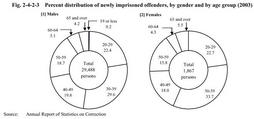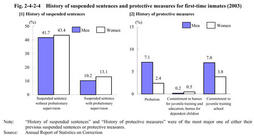| Previous Next Index Image Index Year Selection | |
|
|
3. Characteristics of newly imprisoned offenders The number of newly imprisoned offenders in2003increased by1,078(3.6%)from the previous year to31,355(29,488males and1,867females).The female inmate percentage increased by0.3points from the previous year to6.0%.
(1) Age Fig. 2-4-2-3 shows the percent distribution of newly imprisoned offenders in2003by gender and by age group.
Fig. 2-4-2-3 Percent distribution of newly imprisoned offenders,by gender and by age group(2003) The percentage of the aged persons in newly imprisoned offenders has been on an upward trend.In2003,2,929(2,747males and182females)were60years of age or over,up by325from the previous year,and they accounted for9.3%of the total,up by0.7points(1,351were65years of age or older,accounting for4.3%of the total).Among convicted inmates staying in penal institutions as of December31,2003,some6,683were60years of age or over(1,253were70years of age or older),accounting for11.0%. (2) Type of offenses In examination of offenses committed by newly imprisoned prisoners in2003,the following five offenses had high percentages for male inmates:(1)theft(29.0%),(2)Stimulant Drug Control Law violations(20.6%),(3)fraud(7.0%),(4)Road Traffic Law violations(6.9%),and(5)injury(5.7%).The following five offenses had high percentages for female inmates:(1)Stimulant Drug Control Law violations(38.0%),(2)theft(24.5%),(3)fraud(10.6%),(4)homicide(4.6%),and(5)Road Traffic Law violations(3.2%)(see Appendix2-7).
For male inmates,theft accounted for the highest percentage,followed by Stimulant Drug Control Law violations.This pattern has continued since1998. For female inmates,the percentage for Stimulant Drug Control Law violations has been the highest since1978.Although its percentage has been on the decrease since1998,there have been no decreases in the number of imprisoned inmates. (3) Typeofsentenceandtermofimprisonment By type of sentence of newly imprisoned inmates in2003,99.2%(31,090inmates)were sentenced by imprisonment with labor,and the rest of them were by imprisonment without labor(0.8%or240inmates),penal detention(0.1%or24inmates).A death penalty was executed for one inmate in2003.
Classifying the term of imprisonment of newly imprisoned offenders sentenced to imprisonment with labor into five groups,"one year or less,""more than one year but two years or less,""more than two years but three years or less,""more than three years but five years or less,"and"more than five years(including life imprisonment),the percentage of"more than one year but two years or less"was the highest at 36.4%(see Appendix2-11 for the long term trend in term of imprisonment). (4) Percentage of first-time inmates The rate of persons imprisoned for the first time in all those newly imprisoned has been over50%since2001,and rose further to51.9% in 2003.
(5) Historyofsuspendedsentencesandprotectivemeasuresforfirst-timeinmates Fig. 2-4-2-4 shows the histories of suspended sentences and protective measures of the 16,261 first-time inmates
(14,960males and1,301 females)newly imprisoned in2003. Fig. 2-4-2-4 History of suspended sentences and protective measures for first-time inmates(2003) (6) Frequency of imprisonment Of all offenders newly imprisoned in2003,repeat convicts(those who had previously been imprisoned once or more)accounted for48.1%.By type of offense,repeat convicts were most frequently found in those imprisoned for theft for males(32.5%)and Stimulant Drug Control Law violations for females(54.1%).Those inmates who had previously been imprisoned four times or more was5,620,accounting for17.9%of the total,among which those imprisoned for theft and Stimulant Drug Control Law violations accounted for62%(see Appendixes2-8 and 2-9 ).
|

